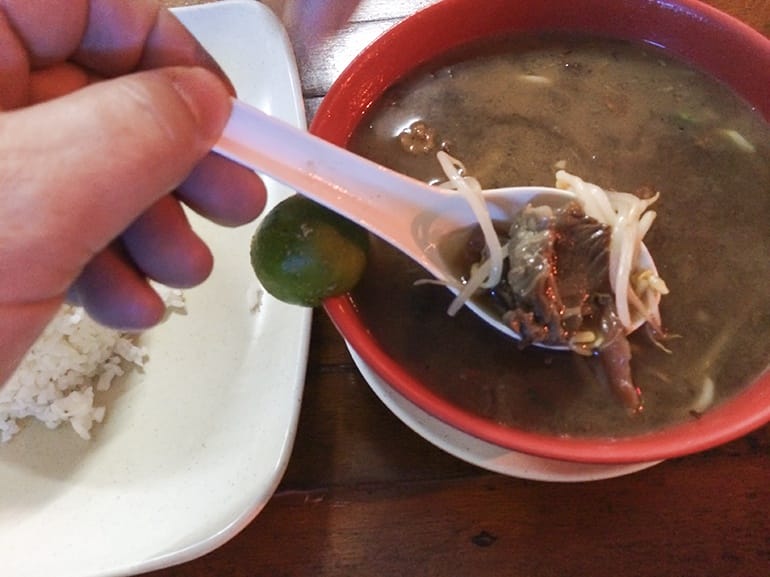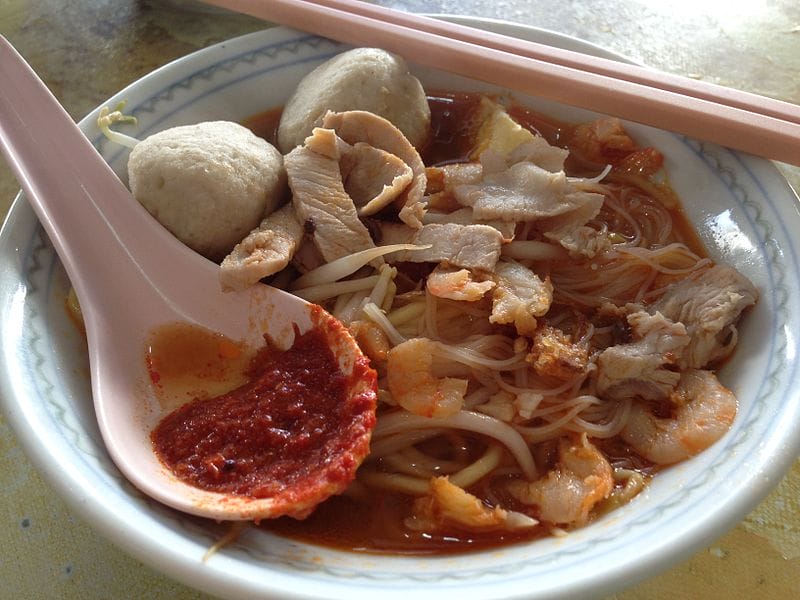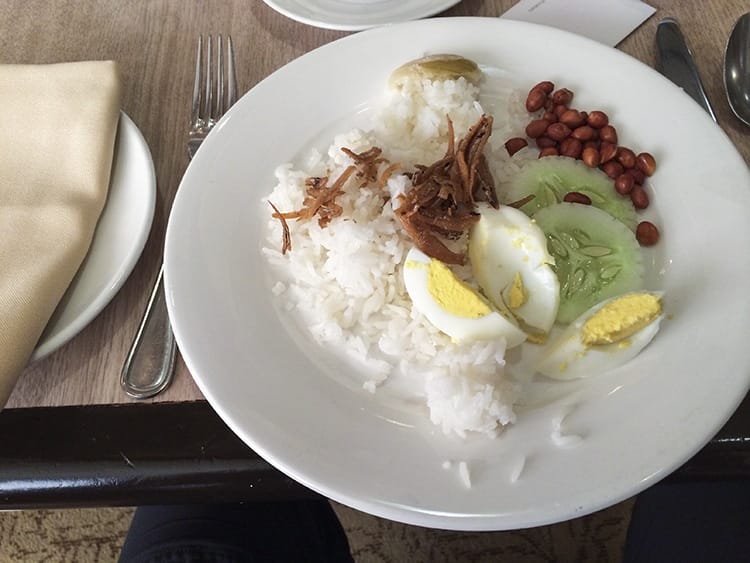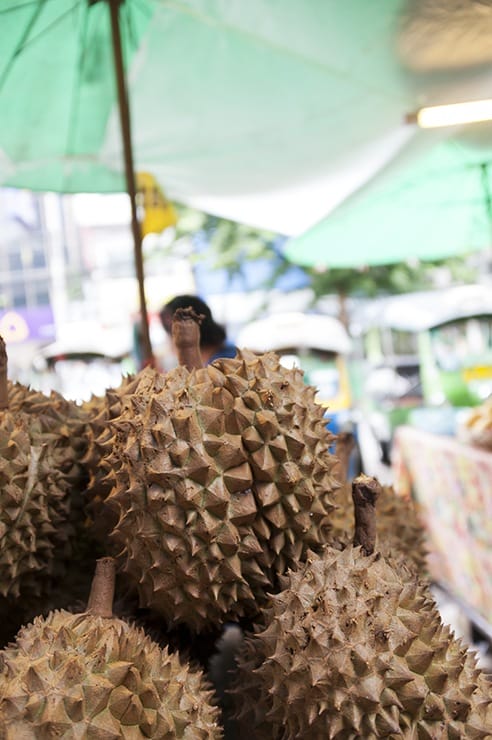We love Penang so much we can’t stop writing about it. Why is that? We have already shared our favourites with you in our Five Quick Tips Penang and in our Butterfly Farm photo story. The reason why we love the island so much is one, pure and simple. Food.
As an avid traveller and a massive foodie, I am sometimes asked what is the best food destination in the world. My answer is always Penang. My time on the island was largely spent eating my way around the array of hawker dishes that make Penangite cuisine one of the most famous in Southeast Asia.
In this post, I am going to try to offer an overview of Penang in ten hawker dishes. Ten specialties that represent the soul of the island, its culture and traditions. The colourful, spicy mix of Indian, Chinese and Malay culture that becomes tangible in the fragrant aromas and flavours of hawker dishes. I have chosen ten, and the last one is not actually a dish, but it’s my favourite food ever.
Where to eat these dishes? Check this great blog post for info on addresses and some great food pics. Whenever I am in Penang, I only ever eat street food. Hawker culture in Penang rules, with food carts on every street corner specialising in single dishes. My Penangite friend said that even starred restaurants head to the streets to get that special curry mee or char kway teow, which is then passed off at theirs at ten times the price.

There is only one way to start this: char kway teow. It’s a typical Penang dish of fried noodles, not dissimilar to a pad thai in look. In taste, it’s miles superior. None of that Khao San Road nonsense; char kway teow is a delicious, multilayered dish that reveals itself with every bite. One bite, you get the noodles and the tofu, then cockles, Chinese sausage, the crunchiness of beansprouts. All infused with a delicious salty-spicy sauce.
It is much more than a hawker dish. It is one of the symbols of Chinese culture in Penang. Chinese culture is everywhere you look in Penang; smoke floats from Taoist temples, trade goes on into the old shophouses; many of the languages spoken in this multicultural city are Chinese dialects. 40 per cent of Penang citizens are of Chinese descent. The dish arrived to Penang with Southern Chinese immigrants who worked as labourers, farmers and cockle-pickers. The dish is very high in fat, so it was filling and so easy to throw together that many Chinese began to hawker char kway teow in the evening to supplement their wages.
A salty-spicy char kway teow leaves you in need of something refreshing. You could go for fragrant coconut, a glass of sugarcane juice, or maybe teochew cendol, which is something in between a drink and a dessert. Imagine a mountain of shaved ice sitting atop colorful jelly cubes, sweetcorn and sweet beans, drizzled with palm sugar syrup. Sweet yet refreshing, it’s the perfect relief to the heat of Penang.
Teochew Cendol is a typical Nyonya dish. Nyonya culture is unique to the Straits area of Malaysia, born from the marriage of Chinese tradesmen and sailors with Malay women. Nyonya cuisine is famous for its desserts, beautiful colorful morsels infused with coconut and sweet bean flavours.
3. Hokkien Mee

Let’s get onto soups. In order to celebrate Chinese heritage, it’s essential to talk about soups. Noodle soups are staple food in Chinese culture; I have chosen two delicious soups for this list, but I could have chosen twenty. The first one is Hokkien mee. To be precise, the same term is used across Malaysia to denote a rather bland dish of stir fried noodles in thick soy sauce. That’s not what I’m talking about. I am talking about a huge bowl of steaming prawny stock, enriched with the chilli paste that is almost always served on the spoon (so you have to add it in order to be able to use the spoon to eat). A mixture of yellow noodles and thin rice noodles, prawns, boiled egg and pork falling from the bone.
4. Curry Mee
The second one, curry mee, is another example of a successful marriage between Malaysian and Chinese culinary traditions. Once again, thin white and yellow noodles are mixed together, alongside prawns, tofu, squid and maybe others; all of the above swimming in a curry-coconut soup reminiscent of Malaysian laksa, but much spicier.
There’s another ingredient to tantalize courageous souls; congealed pig’s blood. After observing the cubic lump of blood sitting on my spoon for about ten minutes, I gave in and swallowed the morsel. Now you would expect me to start talking about how amazing it was, about the depth of flavour and supreme texture. To be honest with you, pig blood tastes of nothing.
5. Roti Canai

How can we forget Malaysian and Tamil heritage? I have chosen two breakfasts, perhaps not unique to Penang itself, but more representative of the whole of Malaysia. One is roti canai, essentially South Indian roti with some curry sauce for dipping. My friend said the price for roti canai is controlled and cannot be more than RM1 per piece; that’s pretty much all we ate when we visited Langkawi. Perfect in its simplicity; moist, ghee-infused roti mixing with the deep earthy flavours of curry.
6. Nasi Lemak

The traditional Malay breakfast couldn’t be more different; the flavours of nasi lemak are sweet and spicy. A portion of rice cooked in coconut milk with a side of fiery sambal, a boiled egg, peanuts and crispy anchovies.
We ate nasi lemak several times during our stay in Penang and the rest of Malaysia, wrapped in banana leaves from hawker stalls and from hotel buffets, in bus stations and on the beach, even once on a plane. It never had the same flavour twice. Nasi lemak is one of those dishes that changes from shop to shop, from family to family. The basics are always the same, sweet coconut rice and spicy sambal. Sometimes it came with cucumbers, others with chicken or beef curry.
7. Teh Tarik

All this food, you need to wash it down with a drink. A frothy, milky glass of teh tarik would be my usual choice. Teh tarik translates as ‘pulled tea’. What is is? Walking around a Penang hawker centre, you’ll definitely notice sellers pouring tea from one jug to another, raising and lowering their hands to create metre-high tea streams. The milky tea is whipped into a delicious frothy drink, silky to the taste.
8. Oyster Omelette
This is the ultimate guilt food. Delicious indeed, but so rich in fat that a couple of bites will leave you stuffed. As a European, I had only ever eaten raw oysters, so when my friend suggested I tried oyster omelette I wasn’t convinced. Walking around the hawker centre, he led me to a stalled manned by an elderly lady who was whipping eggs at lightening speed and mixing them with fat, chunky oysters. The oysters were deliciously plump, complementing the crunchy egg perfectly. Trouble is, I spent the rest of the afternoon sleeping.
9. Asam Laksa
Hands up if you haven’t tried laksa. The spicy, coconut-milky Malaysian soup needs no introduction, being featured on menus from London to LA. Asam Laksa is another story. The colour is not sunset-orange but red-brown, the flavour is pungent, loaded with tamarind paste. It is lighter and more refreshing than regular laksa, but the tamarind tanginess might be a bit of an acquired taste.
10. Durian

- If char kway teow was the only way to begin, durian is the only way to end this exploration of Penang cuisine. Durian is a basketball sized fruit covered in spikes revealing custardy pods wrapped around a seed. Loved or hated, feared or revered, it is a unique Southeast Asian delicacy. It gives a pungent smell, that has been described by non-durian lovers as ‘rotten pig spleen’, ‘fermented septic tank’ or simply ‘shit’. To a durian lover, the flavour is pure heaven. It is absolutely, hands down, my favourite food on the planet. Durian flesh is creamy and rich, sweet but earthy at the same time.
Penang is heaven for a durian lover like me. Penangites are crazy about it and have developed several durian varieties; from sweet, deep yellow durians to a smaller pale pink variety with a faint bitter aftertaste. Durian sellers are artists in carving out the fleshy pods from the spiky casing. Have a look at the hawker in action in this video!

I know this is probably not a very original comment, but it’s true: your post made me hungry ;)! I’m not a big fan of Penang, but hey, the food was great (like everywhere in Malaysia)! So diverse :)!
Thanks Manouk! Give Penang a second chance!
Lovely Durian! Have you tried it? I laughed so much when I read this comment. Thanks!
Thanks Karen! Which one do you love better? Malaysian or Italian?
Like the look of the first dish – looks fresh and refreshing.
Margherita… don’t be tricked by the “I absolutely love your site.. ” comment. That’s spam, probably from a bot – look at the anchor text they’ve entered in the name field!
Thanks for the tip Paul. I was actually wondering about that for a while before I approved it. Spammed it now. Thanks.
I’m surprised that Hokkien Mee has pork because Malaysia is a Muslim country. No Muslim would eat pork; it’s forbidden.
As for durian, I had a durian milkshake in Indonesia and spent the next few hours with burps that constantly reminded of the flavor: something like a garbage dump. Nasty. 🙂
I know it’s weird, I am one of the very few Westerners that loves durian. It’s true, I absolutely love it! Penang has a very strong Chinese influence and there are loads of dishes that contain pork. Malay hawker stalls are usually marked by green and yellow banners. Hope you liked the post! Thanks for reaching out.
These photos look amazing! I always say that the best food in Asia in my opinion is the one in Malaysia, such a great mix between Chinese, Indian and Malay food! And the Durians, I really didn´t like them and the smell…Oh my God! i remember there were hotels with signs “No Durian” before you enter 🙂
I am a bit of a weirdo indeed, I’m crazy about durian! The rest of Malaysian food drives me crazy too, I put on ten kilos in a month and a half! Thanks for your comment!
It’s just so interesting to me that I come across this post. My wife and I have yet to make it to that part of the world, but we love the food. We actually go to this restraurant on Christmas here in Central N.J. I don’t venture into the too exotic dishes though, such as the ones you show here. (Tripe … ? Hmmmm. And you love durian?! Amazing. Lol.)
http://www.penangprinceton.com/
Thanks for your comment John! I am a real weirdo when it comes to food, I love tripe and durian. People think I’m joking when I say that, but it’s actually true!
YUM! I will take one of each please, and two of the first picture. I’ll pass on the Durian though ha..
Hey Samantha! Ok then, another durian for me! Malaysian food is incredible, I’m hungry again just thinking about it!
Even as vegetarians a lot of these dishes look amazing! It’s funny how divided people are on durian. I’m definitely not a fan. Even when I got past the smell, I still didn’t enjoy it. But it is a pretty impressive fruit to look at haha.
Hey Jules! There’s so much veggie food in Malaysia, lovely banana leaf thalis… YUM! Of course, you can always have some durian… just kidding! I’m one of very few Westerners totally crazy about the stuff!
Wow, I should not read too much of these kind of posts! It really makes me hungry!
Love your teh tarik seller picture. Great click at the right moment!
Thanks for your comment Grietje! I’m hungry too thinking about Malaysian food, my favourite food ever!
Great list! I’m starving now. I tried a lot of these when I was in Penang, and would love to try them all again. The smell of the durian really puts me off. I did try it once in some kind of pastry, and it was okay. However, I’m sure the fresh fruit tastes a lot different. I was in Chiang Mai this winter, and was surprised at the price of it. A small piece was running 250Baht.
Hey Nancie! Thanks for your comment! I know it’s strange, but I do love durian. I once spent £50 to buy one in London! So expensive, and it wasn’t even that good!
I didn’t even know oyster omelettes existed until reading this! Nice, delicious roundup.
Hey Dave! Thanks for your comment! The oyster omelette was a little weird at first but actually tasted superb!
This all looks amazing! I missed all these great dishes when I was briefly in KL so I guess we will have to go back to Malaysia. Not sure if we will retry durian though…
Hey guys! Thanks for your comment! You definitely need to go back to Malaysia to try more of the food! Maybe also to give Durian a second chance!
Thanks for that – Malaysia is definitely on my bucket list! Honestly, I’m not familiar with many of these foods – but they look delicious!! It doesn’t help that I’m hungry as I read this post. Love your photos too!
Thanks for your comment Jennifer! Malaysian food is really delicious, and so diverse there’s something for all tastes!
Malaysian/Singaporean food is awesome. I’ve been living in Singapore for 2 years and it’s been the best 2 years of my life in terms of food!
Oh Jon, I’m so envious! I love food in Singapore too, amazing!
I don’t blame you for taking so much time sampling this cuisine! Even though I am not too fond of Asian cuisine in general, I can certainly appreciate that there are some really great dishes here.
Thanks for your comment Chris! I am a great fan of Asian food and Malaysian is my all-time favourite!
Oh my goodness these dishes are making me really hungry and I havent even had breakfast yet. I will keep this list for my visit there so I can go on the hunt for these meals.
Oh Bianca, you definitely won’t go hungry in Penang! Best food of the whole planet! Thanks for your comment!
Hi Emily! You have to go back to Malaysia then, best food of the globe! An excuse to go back indeed!
Thanks for your comment Koty! The food is amazing all over South East Asia, Malaysia was my favourite! I’m sure you’ll love the food!
Thanks for your comment Britany! No problem then, another durian for me!
Thanks for your comment Fie! I know durian is very strange, people think I’m crazy when I tell them I love it!
Thanks for your comment! Teh tarik is really tasty, and of course watching sellers make it is half the fun!